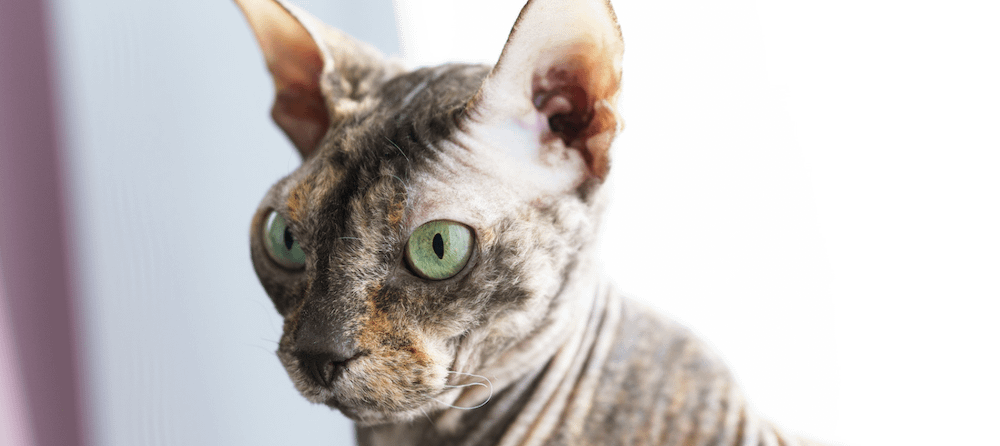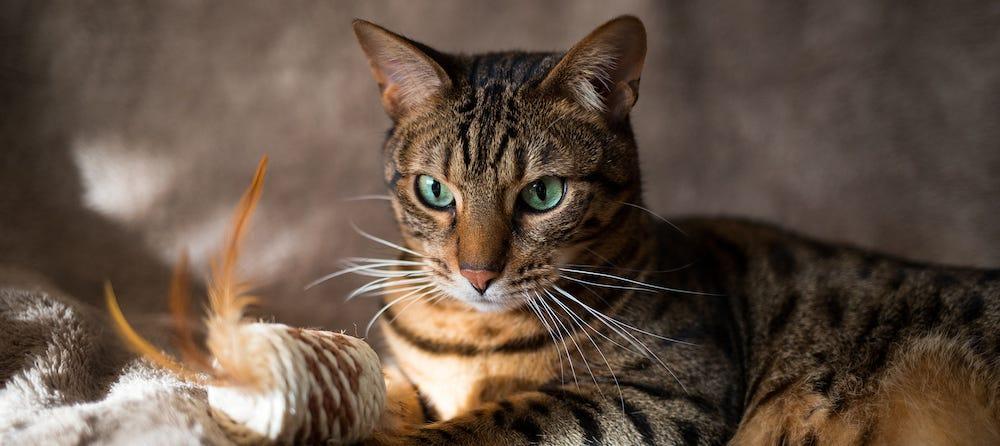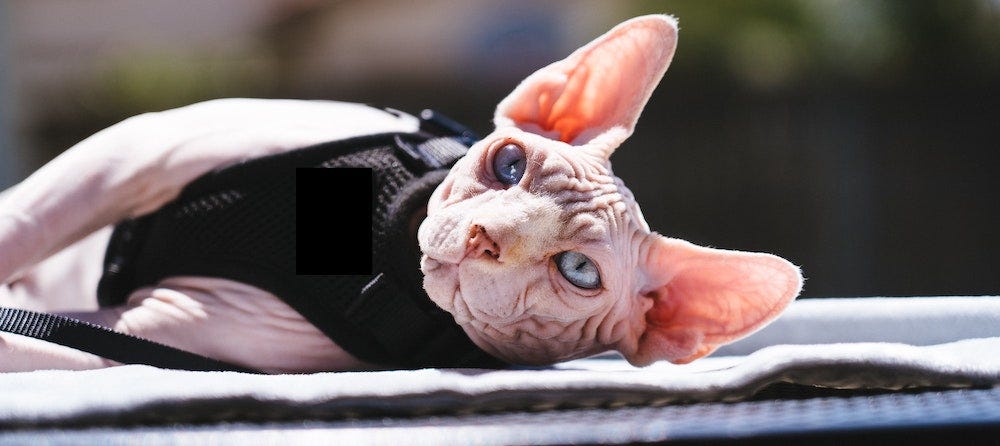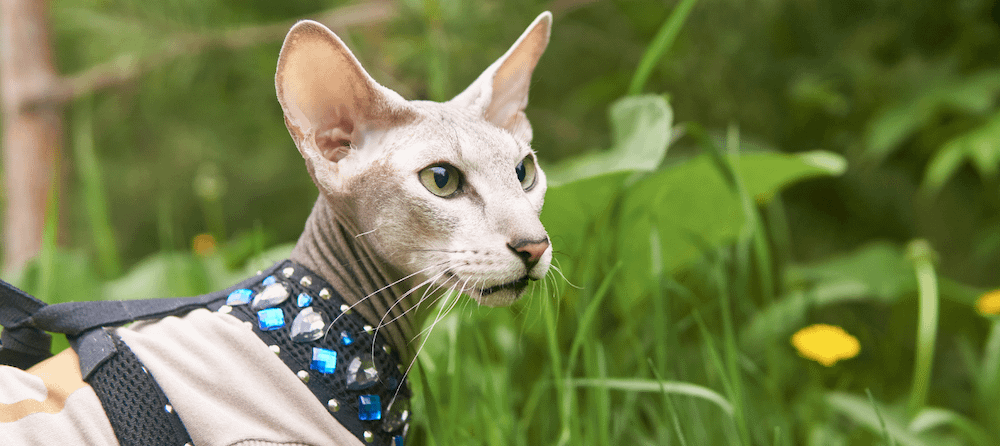The dog-like Donskoy is a hairless cat that will be an extremely loyal companion and bring lots of entertainment into your home. They are recognized for their lack of hair and can often be confused for the Sphynx cat breed. The Donskoy goes by other names, such as the Russian Hairless cat and Don Sphynx. However, they are an entirely different breed from the Sphynx.
The Donskoy is known for their friendly demeanor and a love for being warm and comfy—especially during the winter. They are outgoing and playful, and can be slightly mischievous creatures. It’s best to keep an eye on your valuables so that they don’t get knocked off shelves.
To learn more about the Donskoy and what life would be like with them, continue reading!
| Donskoy cat | ...at a glance |
|---|---|
| Personality | Affectionate, outgoing, playful |
| Life expectancy | 12-15 years |
| Weight | 6-15 lbs |
| Coat & colors | Hairless, flock, velour, or brush; various colors & patterns |
| Energy level | Medium |
| Affection level | High |
| Friendliness | High |
| Shedding level | Low to Medium |
| Required grooming | High |
Overview of the Donskoy cat
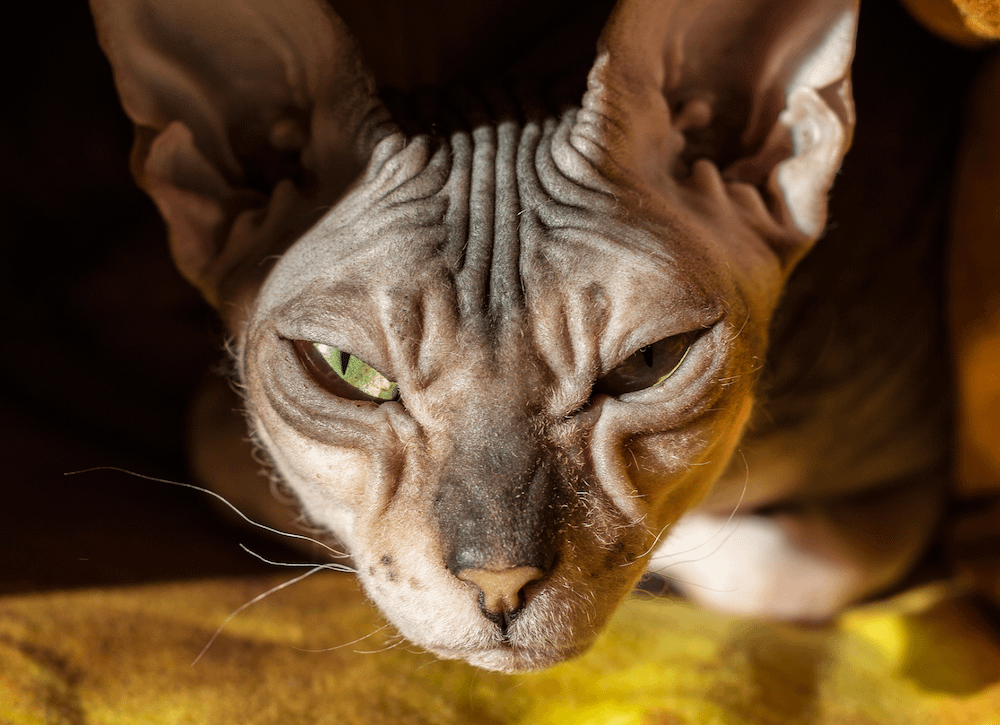
The Donskoy is a medium-sized cat that is most easily recognized for their hairless bodies, large eyes, and wide ears. They are muscular and active, with strong bodies despite what one might assume from looking at all of their skin wrinkles.
Donskoy cats can have a variety of coat types and colors, and they come in a variety of sizes.
Weight
The Donskoy cat can range quite a bit in size, from being on the smaller side at 6 pounds to growing as large as 15 pounds. A female Donskoy may be smaller in size than a male, but this is dependent on genetics, exercise, and nutrition. Because the Donskoy is a rather active breed, they are adept at maintaining their own weight without too much help from their humans.
Length
The length of a Donskoy cat usually falls between 13 and 16 inches. Donskoys are known to be rather slender and can appear very lengthy. They have long tails, proportionate bodies, and hind legs that are longer than their front legs.
Coat
The coat of a Donskoy truly varies. While they are known to be hairless, there are actually four different coat types that a Donskoy can have: rubber bald, flocked, velour, and brush. They come in all colors and patterns found in cats, so your Donskoy is likely to be one-of-a-kind and easy to spot in a crowd.
Donskoys can be very wrinkly, which means that grooming requirements are pretty demanding. They may not look like they require much grooming, but it’s quite the opposite.
Life expectancy
Donskoys cats can live long and happy lives, especially with proper care, nutrition, and exercise. They are known to live for 12 to 15+ years comfortably, and if you want to prolong their life, regular veterinarian appointments are necessary and helpful!
History of the Donskoy cat
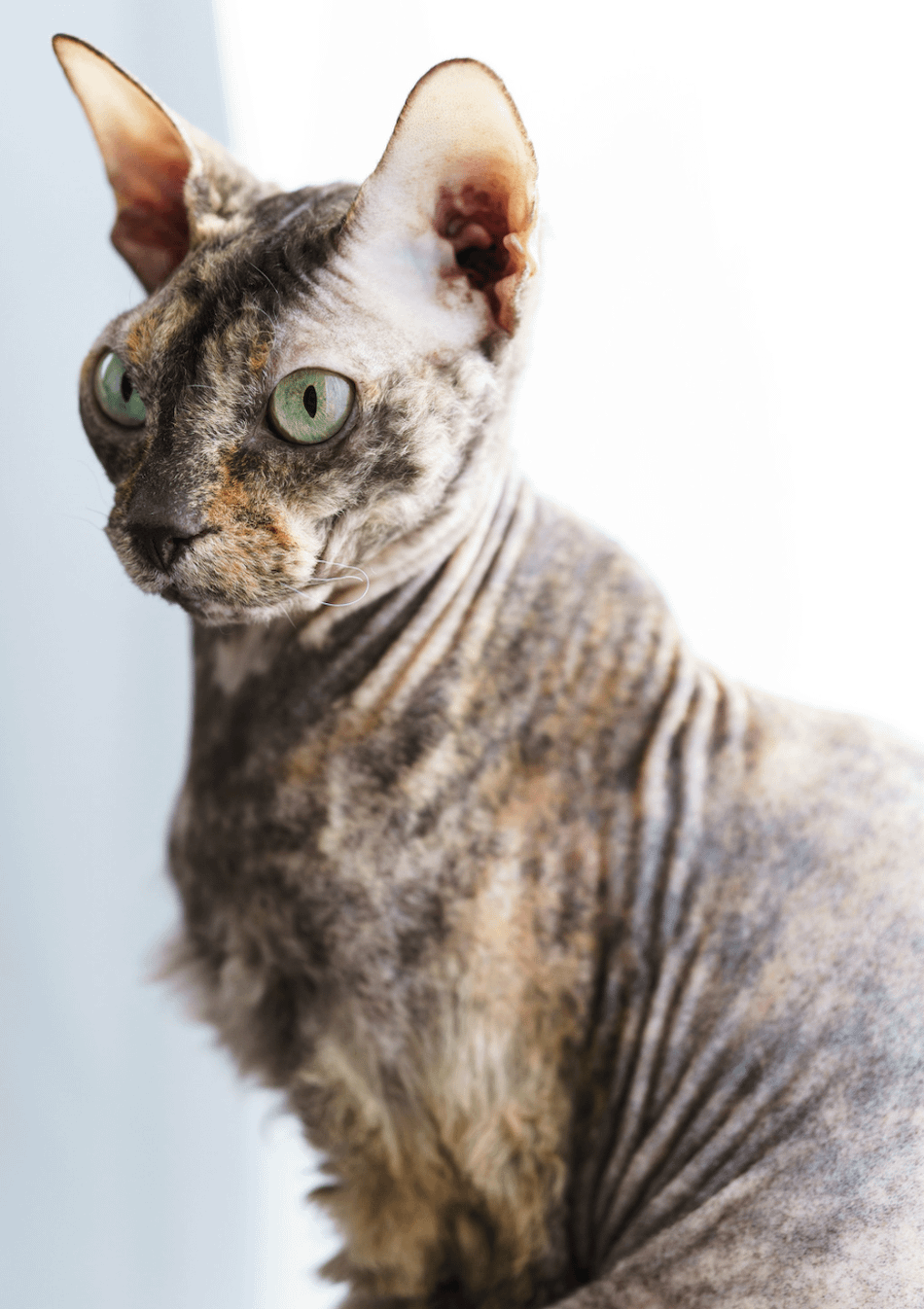
The Donskoy cat originated accidentally. This breed was first discovered in the 1980s by a professor at the State Pedagogical Institute in Rostov-on-Don, Russia. Professor Elena Kovaleva found a kitten being mistreated by a group of children and took her out of harm’s way. She named this cat Varvara, and after just a few months, Varvara lost all of her hair.
At first, the hair loss that Varvara experienced was thought to be related to some kind of medical issue. Professor Kovaleva took her in for various treatments that were ultimately unable to treat the baldness. There wasn’t much thought about the cause until Varvara mated with a local tomcat, and half of the litter were born without hair. Then a few months later, the rest of the litter lost their hair, leaving all of the offspring bald.
While there was nothing out of the ordinary regarding their health, people thought that the kittens must have some sort of illness, and discouraged Professor Kovaleva from further breeding the cats.
The Donskoy we know today
When a professional breeder, Irina Nemikina, rescued one of the offspring of Varvara, she noted the unique hairlessness and wanted to figure out if it was an illness or a genetic mutation being passed down. The hairlessness continued throughout each litter that was born, which made Irina realize that it was a genetic mutation that the offspring were inheriting.
Her breeding program helped determine that, unlike the Sphynx cat, the Donskoy’s hairless gene was dominant rather than recessive. That meant that only one parent had to have the gene in order for it to be passed down.
Characteristics of the Donskoy cat
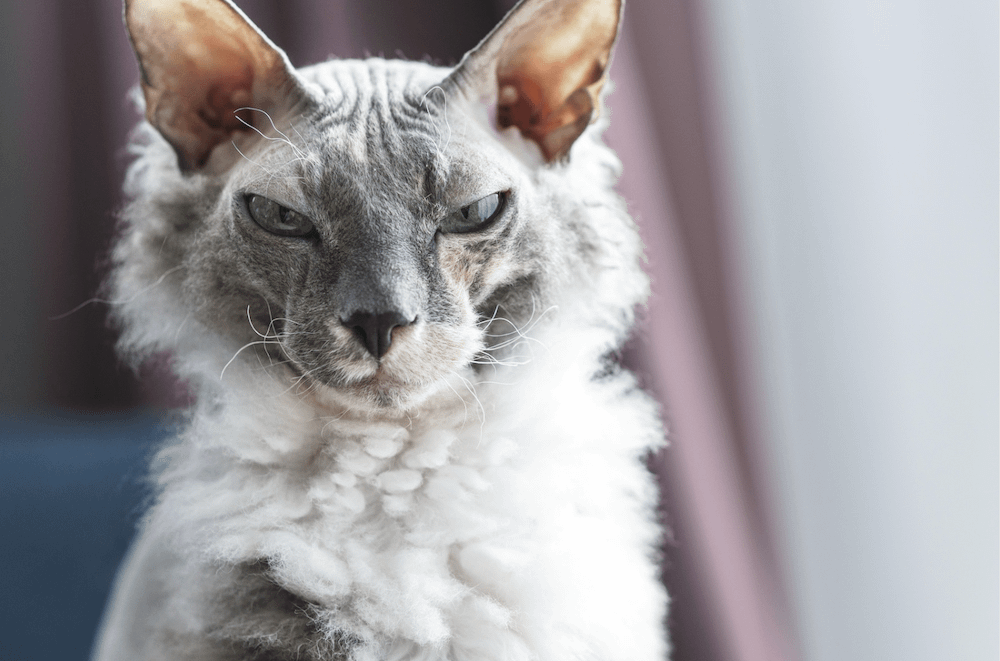
The Donskoy has a solid and muscular body. They have wedge-shaped heads and high cheekbones that only enhance their large eyes and alert ears. Their many wrinkles cover their entire body and give them a slightly angry appearance around the face. Don’t let that fool you—they are extremely outgoing and playful!
Hairlessness is the most obvious trait that most Donskoys have. Despite being known for their hairless appearance, the Donskoy can have four different coat types:
- Rubber bald: These cats are born hairless and stay that way for the entirety of their lives.
- Flocked: These cats are born and appear to be hairless, but actually have a chamois-like coat. In some cats, this hair falls out by the 2-year mark. Some cats will have this coat for the entirety of their lives.
- Velour: These cats are born with a velvet coat minus one bald spot on the crown of their heads. Most of the hair on these cats will fall out over time, but some might remain in patches on their face, legs, and tails.
- Brush: These cats might not immediately be associated with the Donskoy because they are born with a thick wavy or wiry coat that remains for their entire lives. However, they may also have bald spots on their heads.
Personality and behavior
Donskoys are known to be affectionate, cuddly, outgoing, and playful. They are not shy around people they know and trust, enjoying when their humans interact with them throughout the day. They are needy by nature—they want to be around their humans as much as possible and become sad when left alone for too long.
Donskoys are often compared to dogs because of how much human interaction they want from their families, as well as the need to be involved in their daily tasks. These cats are intelligent and can be trained to walk on a leash and learn tricks.
Typically, Donskoys do well in settings where other cats or dogs are present, and where children roam free. They adapt well to new environments and people, and their great temperament makes them excellent family pets.
Caring for a Donskoy cat
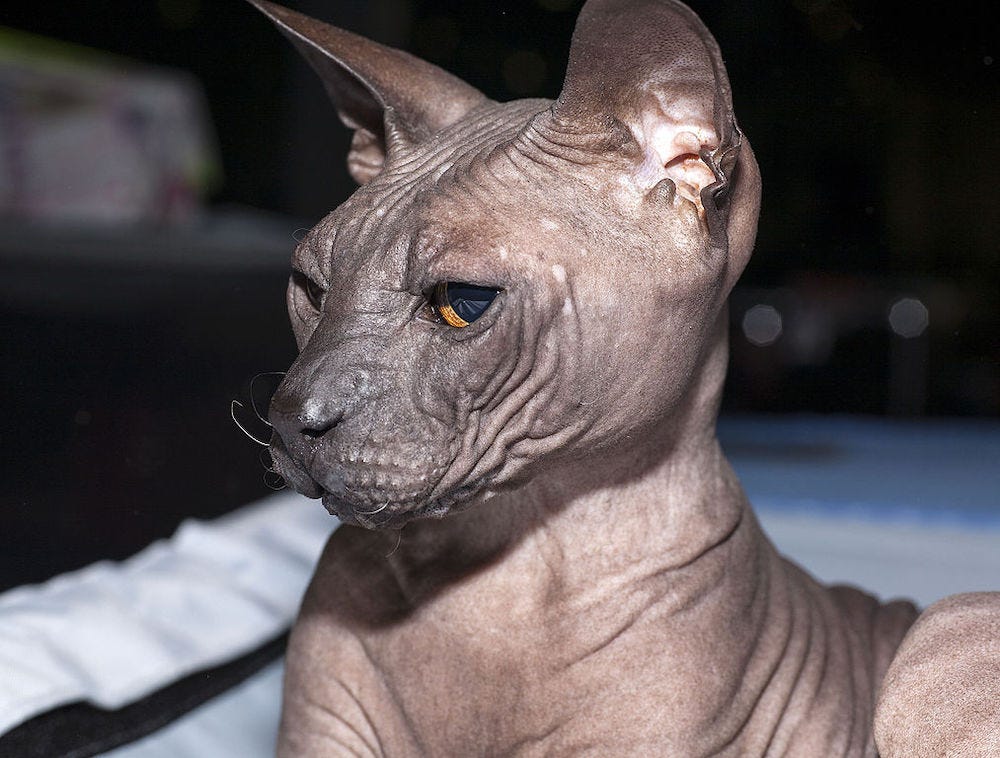
When it comes to caring for a Donskoy, many assume that their lack of hair means fewer grooming requirements. We are here to squash that rumor!
Instead of doing the bare minimum, you must be on top of your game to care properly for the Donskoy. When not properly cared for, hairless cats are prone to skin infections, dryness, and sunburns.
Grooming
This breed is prone to oily skin and needs to be bathed regularly to avoid skin-related issues. You should be wiping down your Donskoy every day to prevent build-up that can lead to rashes and more. With the right encouragement and plenty of treats, this might become a wonderful bonding time for you and your Donskoy.
You’ll want to clean their ears, trim their nails, and brush their teeth on a regular basis. If you need help from a vet for any of these activities, there’s no shame in that!
Additionally, keeping your Donskoy’s litter box clean will help improve their overall comfort and avoid further irritating your cat’s skin. You can keep their bathroom space in top shape with the help of a self-cleaning litter box.
Health-related issues
Like many hairless breeds, Donskoys are prone to skin-related issues. They are easily sunburned, so they need to be kept away from UV rays. Consistent lotioning is mandatory so that their skin doesn’t become too dry.
There is still some genetic uncertainty about this breed that raises questions about their health. While more research needs to be done, there is the thought that the dominant genetic mutation or hairlessness might potentially cause feline ectodermal dysplasia, which can impact a cat’s ability to sweat, as well as their teeth and gum development.
For example, cat show registries like the World Cat Federation and the International Cat Association forbid breeders from crossing the Donskoy with the Peterbald cat. (A pairing between the Donskoy and Oriental Shorthair led to the Peterbald.) The genetic concern here centers around feline ectodermal dysplasia in its homozygous form.
Taking home a Donskoy
While beautiful, the Donskoy is not meant for your average first-time pet parent. They require a high-maintenance grooming regimen and are very needy cats. If you work from home or have a flexible schedule where you can be at home when you please, this cat breed will be more up your alley. Donskoys need a lot of attention.
When you are able to provide your Donskoy with plenty of toys, puzzles, enrichment activities, and love, they will be your best friend for life.
Sources:
- A Deletion in FOXN1 Is Associated with a Syndrome Characterized by Congenital Hypotrichosis and Short Life Expectancy in Birman Cats | NCBI
- Sphynx Cat | Breed Of Cat | Britannica
- Focus: Comparative Medicine: Canine and Feline Models of Human Genetic Diseases and Their Contributions to Advancing Clinical Therapies | NCBI
Photo credit: © Nickolas Titkov / CC-BY-SA-2.0
